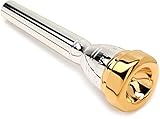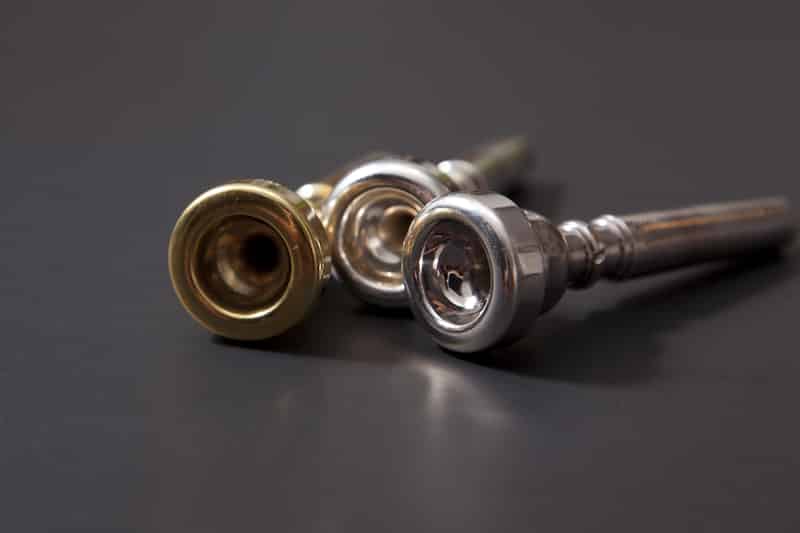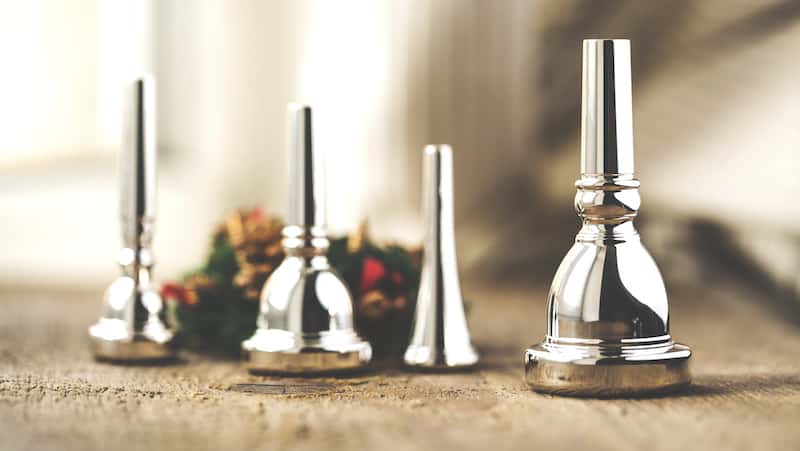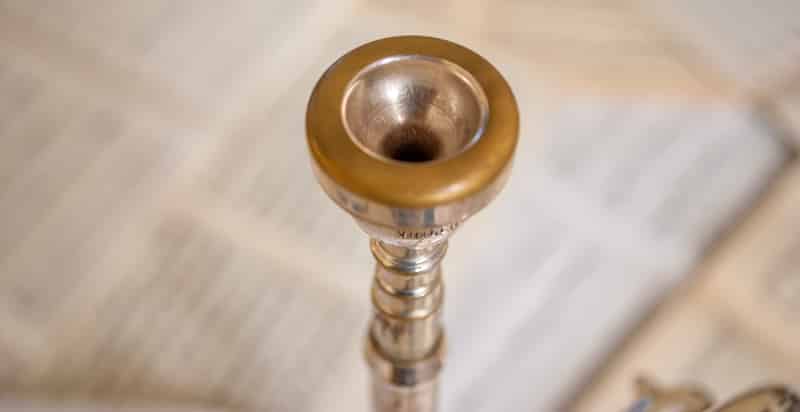Looking to buy a new mouthpiece for your trumpet? Not sure what to look for or what the best brands are? Well in this post, we’re going to walk you through everything you need to know before purchasing a new mouthpiece. We’ll also review some of our favorite models of what we think are the best trumpet mouthpieces on the market. Let’s get started.
Quick Answer: The Best Mouthpieces for Trumpets










Best Rated Trumpet Mouthpieces Reviews
Now that we’ve covered what you need to look for when choosing a trumpet mouthpiece it’s time to look at our favorite trumpet mouthpiece reviews. From the beginner to the professional trumpet player, and for a range of styles, there’s a trumpet mouthpiece for everyone.
1. Selmer Bach K3513C Trumpet Mouthpiece
- Large cup
- Full, rich tone
- Good for all-around use
With a 3C cup and measuring 16.3mm in diameter, the Selmer Bach K3413C is the ideal mouthpiece for players moving from beginner to more advanced playing.
Its a typically large throat allows players to produce a rich and resonant sound effortlessly and brings an added flexibility to playing. The larger cup size gives it a darker, richer tone than other mouthpieces while smoothing out the joins to some of the trumpet’s high notes.
However, customers find that for notes above High C, a 5c or 7c gives the best results, especially for novice players still building their technique. Nevertheless, the Selmer Bach K3513C trumpet mouthpiece is an adaptable mouthpiece that accommodates various musical styles and playing techniques.
Customers add that since the price is higher than others, this trumpet mouthpiece may not be the best trumpet mouthpiece choice for budgeting musicians. But for a dedicated beginner or experienced player looking for a flexible trumpet mouthpiece for long-term use, it’s ideal.
2. Yamaha YAC TR14A4A-HGPR Trumpet Mouthpiece
- Fast-response
- High range and powerful sound
- Ideal for piccolo or lead trumpet
This gold-plated trumpet mouthpiece is ideal for lead trumpet and piccolo players. Classically elegant and easy-to-use, this trumpet mouthpiece is an excellent choice for the trumpet player looking to hone their high notes and enhance their playing.
It has a 16.68mm cup and measures 3.65 mm at the throat. At 2.4 oz, it is marginally heavier than the Selmer Bach trumpet mouthpiece. And the gold plating around the rim adds an extra layer of finesse to this trumpet mouthpiece’s look.
There couldn’t be a better trumpet mouthpiece for players seeking to play high notes for a sustained interval. However, the weight and rim size may give some players difficulty moving into lower musical regions.
Customers add that this trumpet mouthpiece is also pricier than the average, so a better investment for committed trumpet players than novices. For sweet, clear high notes and a smooth sound, though, it is hard to beat.
3. Schilke Standard Series Trumpet Mouthpiece
- Comes with standard rim shapes, cup volumes, and backbores unless shown otherwise on the mouthpieces
- Enables the player to know the characteristics of their trumpet mouthpiece
Like the Yamaha, this silver-plated trumpet mouthpiece works to facilitate the playing and reaching of high notes. This is an affordable, mid-priced mouthpiece that will help the beginning trumpet player get to grips with high notes.
However, some customers report this trumpet mouthpiece tends towards a fatter, louder tone in the middle and low range notes that can be hard to control, especially for novice players.
With a shallow cup, tight backbone, and 27mm throat, this trumpet mouthpiece is a perennial favorite with trumpet players and easily maintained. The versatility of this trumpet mouthpiece heightens its popularity. Perfect for jazz, this trumpet mouthpiece readily adjusts to the needs of other styles and musicianship.
4. Bach 3C Trumpet Mouthpiece
- silver-plated
- medium width rim
- medium cup
The Bach Trumpet Mouthpiece 3C has a medium cup depth in addition to a moderately wide rim. With greater tone and range, it ably suits the needs of maturing intermediate, advanced, and lead trumpet players.
Customers say this trumpet mouthpiece results in an even, open sound that works well across lead trumpet playing, jazz, and classical music. While the cup is deeper than usual when playing high notes, it ably accommodates the resultant lip swelling that some experience from the protracted projection of high notes.
However, several customers received imitation Bach Trumpet Mouthpieces ordering online. To prevent this, customers should source their trumpet mouthpiece directly through a local music store or retailer.
5. Vincent Bach 3511C Trumpet Mouthpiece
- Package Dimensions: 9.144 cm (L) X 3.048 cm (W) X 3.048 cm (H)
- Package Type: Instrument Parts And Accessories
- Package Quantity: 1
The Vincent Bach 3511C has a 1C cup size that results in a relaxed, open-sounding instrument with a broader musical range and dynamics than other cup sizes. While this makes controlling the trumpet tone easier, some trumpet players say it also requires more air and breath control.
It is a lightweight trumpet mouthpiece at 0.64 oz, and silver plating gives this trumpet mouthpiece an elegant look. Some players experience more resistance on higher notes. The even tone of this trumpet mouthpiece balances that. Accordingly, it is well-suited to trumpet players with a median range and less inclination for ‘screaming’ or oscillating across the musical range.
Customers also note that the decreased flexibility of the mouthpiece forces the trumpet player to rely more heavily on skill and embouchure to produce a consistent, high-quality sound. While the experienced musician may appreciate this feature, it may add an extra challenge to the aspiring student.
6. Yamaha YAC SHEWLEAD Trumpet Mouthpiece
- The Bobby Shew Signature Lead trumpet mouthpiece gives that extra sizzle and high note clarity for playing demanding lead parts.
- 16.54mm inner diameter, very shallow cup
- Semi-round and semi-thick rim, narrow backbore
The silver Yamaha YAC Shewlead trumpet mouthpiece has an exceptionally shallow cup coupled with a moderately thick, rounded rim. It has a narrow throat and gives heightened clarity and zest to high notes.
The Bobby Shew trumpet mouthpiece is a favorite with trumpet players who want to play loud, fast, and high with dexterity and panache. The tone is lighter than that of the Bobby Shew Jazz trumpet mouthpiece but still noteworthy.
Customers report that this trumpet mouthpiece adds as much as an octave to their playing. Others note that the Yamaha YAC Shewlead trumpet mouthpiece is an excellent mouthpiece for the out-of-practice player since switching between registers is fast, effortless, and ideal for lead trumpet playing.
However, the rapid register switches command an added layer of breath control that trumpet players might take time to adjust to playing. Additionally, while this trumpet mouthpiece enhances range, some customers say it suffers tonally, reporting that notes above High C sound shrill and can be uncomfortably narrow.
7. Yamaha YACTR14A4A Trumpet Mouthpiece
- Unmatched precision
- Smooth attack
- Secure control
While the Yamaha YACTR14A4A feels and often responds like a 3C trumpet mouthpiece, it is shallower and has a tighter backbone and throat.
Customers describe the Yamaha YACTR14A4A as a comfortable mouthpiece that adeptly reaches high notes. However, others found it a struggle to negotiate the low notes of the musical register.
Widely popular, it has a smooth, even range and tonality that encompasses a variety of playing styles and techniques. In addition to the even-sounding tonality, the silver plating gives this trumpet mouthpiece a smooth feel against the lips, ensuring comfortable, confident playing.
Available at readily affordable prices, this trumpet mouthpiece is a fantastic choice for trumpet players wanting a relaxed sound or looking to experiment with something more than the usual 3C mouthpiece.
8. Paititi 3C Trumpet Mouthpiece
- Bach 3C Trumpet Mouthpiece, Gold Plated, Rich Tone
- Compatible with most standard trumpets, such as Yamaha,Bach, Conn, King, etc.
- Cup: Medium
Available in gold and silver plate, this trumpet mouthpiece makes an excellent option for the intermediate or advanced trumpet player.
This affordable trumpet mouthpiece has a free-flowing sound. Musicians describe this trumpet mouthpiece as having a first-rate smooth tone, easily achievable by trumpet players.
However, a consistent critique is that this trumpet mouthpiece requires regular cleaning of the trumpet’s spit valve by the player. It is also not recommended for marching band use, at the risk of losing the trumpet mouthpiece. But for stationary playing, customers say the rich tone and affordability are worth it.
9. Blessing 3C Trumpet Mouthpiece
- Brand: BLESSING
- Designs based on input from professional players Buff Dillard, Robert Dorer, and Dominick Farinacci.
- Blessing a household name in the world of brass instruments.
Many musicians find this trumpet mouthpiece, with silver plating and medium cup depth, an affordable equivalent to the Selmer Bach mouthpiece models.
Customers say the sound is softer and well-suited to midrange and lower registers, proving especially popular for bugle and taps playing. While this trumpet mouthpiece handles jazz well, it requires extra effort from the instrumentalist to land high notes.
In other respects, the affordability and ease of playing make it a good candidate for beginner trumpet players who may change mouthpieces often or experiment with different trumpet mouthpieces.
How to Choose a Trumpet Mouthpiece: A Buyer’s Guide

Choosing a trumpet mouthpiece can be more difficult than choosing the trumpet itself. There are many different aspects of the interior build and exterior composition of trumpet mouthpieces, and each affects the tone quality and physical comfort of the player.
Given this dynamic range, it is common for trumpet players to have several mouthpieces on hand to fit different genres, lengths of play, special passages, and playing environments.
To help you navigate all this we’ve put together a buying guide covering all the important aspects to consider when deciding to purchase your next trumpet mouthpiece.
Parts of the Mouthpiece
At first glance, the mouthpiece of a trumpet appears to be one small part singular of the instrument.
As a matter of fact, the mouthpiece itself has several distinct components.
Variations in the width and structure of each component produce distinct sound qualities.
Rim and Cup
The journey of air through the trumpet mouthpiece begins with the rim and cup. The rim is the term for the outer portion where the trumpet player purses the lips.
The lips partially extend into the rounded interior just inside the rim, a space that is called the cup.
Generally speaking, the smaller the inner rim diameter, and therefore the smaller the cup, the easier it is to play higher notes but the harder it is to achieve louder volume and maintain high tone quality.
Throat or Bore
The area at the very back of the cup, where the interior of the mouthpiece is its most narrow, is called the throat or the bore.
Think of it as your own throat, and the cup as the inside of your mouth.
There are fewer variations in the throat or bore diameter than in rim and cup diameter because too much restriction in the throat or bore would close off the ability to make sound at all.
However, the general rule remains the same; the narrower the throat or bore, the easier it is to achieve higher notes but the harder it is to achieve louder volume and maintain high tone quality.
Backbore and Shank
The rest of the length of the interior of the mouthpiece is referred to as the backbone.
From the bore or throat to the end of the mouthpiece, the backbore tapers and becomes increasingly wider.
The degree of the taper, and therefore the diameter throughout the length of the backbore, varies from large, which has a slight outward curve, to a medium straight taper, to tight, which is bowed slightly inward.
Similar to the other components described above, the wider the taper of the backbore, the easier it is to reach high notes and the harder it is to achieve loud volume and maintain high tone quality.
The shank is the term for the outer surface of this portion of the mouthpiece.
Type of Player

The type of mouthpiece you need depends on your level of ability and the type of music you will be playing.
Beginners should choose mouthpieces with larger cups.
Due to the differences described above, larger cups will allow you to focus on developing your foundational skills without having to use advanced techniques to achieve volume.
Classical music players also typically chose mouthpieces with larger cups, as volume and tone quality control are more important in this genre than playing in higher registers.
On the flip side, jazz players who need to reach high tones and larger ranges in rapid succession tend to reach for mouthpieces with smaller cups.
Material
Trumpet mouthpieces come in a variety of materials.
The materials used to make the mouthpiece affect more than just the appearance and can actually change the timbre that the instrument makes.
Brass
As a member of the brass family of instruments, it is not surprising that many trumpet mouthpieces are made of brass.
Brass mouthpieces offer a reliable tone quality that is consistent with the rest of the instrument, which is also likely made of brass.
Brass is a softer metal, resulting in a softer sound as a result of it absorbing some of the vibrations.
Nickel Silver
Some of the earliest trumpet mouthpieces were made of nickel silver. A harder metal than brass, nickel silver absorbs less of the sound vibrations.
This allows the vibrations to travel more freely throughout the body of the instrument, resulting in a brighter and louder tone.
Similar results have been achieved recently with sterling silver and stainless steel mouthpieces.
Non-Metal Mouthpieces
Modern trumpet makers have explored the possibility of making mouthpieces out of material other than metal. The primary options are wood and various plastics.
The main disadvantage of these nontraditional mouthpieces is the lack of volume control and brightness of tone.
However, many trumpet players enjoy the warmer tone produced by wood and plastic mouthpieces.
Additionally, these are great options for extremely hot and cold climates, which can make the mouthpiece so hot or cold that it affects the tone greatly and causes discomfort in the player’s lips.
It also provides an option for those allergic to metals.
Finish

Most trumpet mouthpieces are finished in silver plating.
Silver is durable, affordable, and lends itself to the bright tone discussed above.
Some mouthpieces are plated in gold instead.
Gold plating does not change the tone quality of the instrument so much as it feels softer on the lips and adds a more upscale aesthetic.
Weighting
Some trumpet mouthpieces have extra material added behind the cup to make them heavier.
The purpose of this is to add power to the volume, allowing the player a natural way to project sound further.
The trade-off is that articulations become more difficult to control and highlight.
Budget
The mouthpiece you choose will also depend on your budget.
Trumpet mouthpieces come in a wide array of prices, making it possible to find the qualities you need most at a price you are comfortable with.
The simplest mouthpieces made of the most basic nickel and silver compositions can be purchased for less than $10.
These are good options for children and beginners who are still deciding how much time they want to devote to this hobby.
The highest-end mouthpieces can cost several hundred or even thousands of dollars.
These are crafted with gold and higher quality silvers, with extra weighting and more intricate interior design.
The majority of midrange mouthpieces available cost between $50 and $100.
Do You Need a New Mouthpiece?
Given all of the above information, you can now determine if it is time for you to explore the possibility of purchasing a new trumpet mouthpiece.
Do you find yourself dabbling in different genres of music and struggling to achieve the qualities of each genre? Perhaps you need a mouthpiece with a smaller cup to reach the high notes of jazz.
Maybe it is time to buy a weighted mouthpiece because you have just scored your dream solo.
Are you still playing on your original mouthpiece that came with your trumpet and ready for an upgrade in aesthetic and tone quality provided by nicer metals?
If you have decided to start shopping around, here are reviews of some of the trumpet mouthpieces currently on the market.
So, Which One Should You Buy?
When looking into trumpet mouthpieces, it’s important to remember there is no one-size-fits-all solution.
Different players bring individual skills and preferences to the table, and those skills and preferences, play a part in deciding on the best trumpet mouthpiece for trumpet playing.
For the best, most consistent musical outcome, though, our preference is for the Selmer Bach K3513C trumpet mouthpiece.
Its adaptability makes it a good starting mouthpiece for trumpet players still learning to negotiate range and experimenting with style.
The cost of this mouthpiece is counterbalanced by its longevity and its tonal and stylistic flexibility.
And the dark, rich tone produced by this trumpet mouthpiece smooths out the joins between musical registers.
Whatever trumpet mouthpiece you choose, it’s important to remember that new trumpet mouthpieces need an adjustment period. Switching from 1 to 3C or the other way round will create differences in playing and embouchure.
Be sure to allow a settling-in time before deciding if a trumpet mouthpiece is right for you. So give it time, and trust your instincts.
- Large cup
- Full, rich tone
- Good for all-around use





